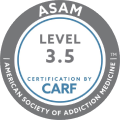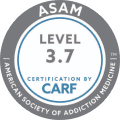Fentanyl is a drug that is widely considered one of the strongest painkillers known to mankind. In fact, it is believed to be between 50 to 100 times stronger than morphine. It also has a structural analog known as carfentanil that’s believed to be more than 10,000 times as potent as morphine and strong enough that it was once employed as a dispersed aerosol agent in a hostage situation to render terrorists and hostages incapacitated.
In the medical community, fentanyl is a drug that’s normally prescribed in situations where a patient is dealing with:
- Cancer
- Breakthrough pain, especially in patients who are already on 24/7 narcotic treatments
- Severe post-surgical pain
Prescription delivery methods include lozenges, skin patches, injections, topical sprays, and nasal sprays. These are sold, respectively, under the brand names Actiq, Duragesic, Sublimaze, Subsys, Abstral, and Lazanda.
Unfortunately, both fentanyl and carfentanil are also increasingly being sold on the street to customers who used to purchase opiates like heroin. Law enforcement officials report seeing increasing numbers of cases in which fentanyl and carfentanil are being cut with other substances, such as heroin, cocaine, meth, and even MDMA.
It’s especially popular to cut fentanyl with drugs that are delivered in white powder forms, and dealers like to use it in their products because it creates a very quick high and can be heavily diluted while maintaining significant potency. Worse, laboratory-grade fentanyl is now arriving in the U.S. from China in a wave that threatens to dwarf the existing opioid crisis.
Fentanyl addiction is a growing issue in the U.S., even as efforts to combat the opioid crisis have improved. For this reason, it is wise to know a bit about its side effects, what withdrawal is like, and how people can detox.
Side Effects
The side effects of fentanyl are similar to ones associated with opiates and opioids, but they’re often more amplified. Users have reported unusual dreams and thought patterns, and anxiety and depression are common. Uncontrollable shaking of individual body parts has also been noted.
Not surprisingly, many people who use the drug state that they have trouble getting to sleep or remaining asleep. People who use it are often drowsy, and they may have blurry vision, too. It also has a strong influence on both digestion and hydration, and this can give rise to side effects like:
- Gas
- Heartburn
- Trouble urinating
- Stomach pains
- Severe and rapid weight loss
- Constipation
The face, chest, or neck may also redden. There is the possibility that the hands, feet, arms, ankles, or legs may swell.
Individuals using the drug should inform a doctor immediately if they detect any of the following issues:
- Hallucinations
- Itching, hives, or rashes
- Seizures
- A decline in sexual interest
- Vomiting or nausea
- Agitations
- Shifts in heartbeat
- Changes in menstruation patterns
There is also a serious risk of respiratory or cardiac episodes when using the drug. You should contact emergency services immediately if you or someone you know experiences:
- Shallow breathing
- Confusion
- Fainting
- Extreme drowsiness
- Trouble swallowing
- A decline in the urge to breathe
Current research indicates there is also a possibility that prolonged abuse of opiates and opioids may lead to brain damage. A study of IV heroin users who died at an average age of 26 concluded that those users had brains that appeared to be similar to those seen in Alzheimer’s dementia patients. It is reasonable to assume that fentanyl, a drug that is functionally a much more potent version of others in the same class of analgesics, is likely to have similar effects.
Folks who abuse the injected form of the drug may also be at heightened risk for blood clots. Some patients who have used fentanyl in oral form have reported having pain, sores, or irritation in their mouths at the spot where the drug was delivered.
It’s not entirely clear why, but blood-pressure spikes associated with other opiates and opioids are less common in fentanyl users. This may be due to the drug’s faster action and smaller total concentration.
Growing tolerance for the drug is a major problem. Many prescription patients engage in abuse patterns because over time, their dosages don’t curb pain as much as they did before. This lack of potency causes many users to seek greater amounts of the drug. Some may go to street drugs when they’re refused additional dosages by medical practitioners.
Overdose Risk
In addition to these side effects, there is also a significant risk of an overdose occurring. Naloxone is a drug designed to reverse these effects very rapidly, and most first responders and police officers in the U.S. now have access to it. It is available in a spray form that can be utilized by non-professionals with training, such as family members, and you can acquire naloxone if you have any worries about a potential overdose occurring. The injectable form of naloxone, however, should only be administered by a medical professional who has training. These drugs are sometimes marketed under the brand names Narcan and EVZIO.
You can identify an overdose in progress by noting a few signs. These include:
- Confusion, dizziness, and drowsiness
- Shallow or halted breathing
- Shrunken pupils that look like tight, black dots
The Withdrawal Process
First, it should be noted that a person who has stopped using fentanyl is at no risk of dying during the withdrawal process. While overdose risks are high and the actual pain of withdrawal is often significant, a person will not die simply because he or she cannot get a hit of the drug.
One challenging issue with the drug is that its half-life in the human body is highly variable, with the main issue being how the drug was administered. Its duration of action is 30 to 40 minutes, and that’s why it’s often sold as a time-release patch. Administered intravenously, it should have a half-life between two-and-a-half and four hours. Other delivery methods may be a bit slower, with half-lives approaching seven hours.
The half-life of a drug in the body is how long it takes for the amount in a person’s bloodstream to be cut in half. This happens because the body filters drugs out by way of the liver and the kidneys. If a drug has a four-hour half-life, only 50 percent of the original dose will be present four hours later. By eight hours, it will be down to 25 percent, and by 12 hours, it will be down to 12.5 percent.
On balance, the short half-life of the drug ensures that most people will begin to experience withdrawal symptoms fairly rapidly. Cravings will start to kick in within 12 to 30 hours. Body and muscle aches are also common, and these often happen in parts of the body where the individual was not previously treating pain. It comes as no surprise that most patients also experience the return of the original pain they have prescribed the drug to treat when they stop using this opiate.
Many of the previously listed side effects of taking the drug also appear during the withdrawal process. The return of other bodily functions can produce significant discomfort during withdrawal. Issues may include:
- Diarrhea
- Vomiting
- Sweating
- Chills
- Goosebumps
- Abdominal cramps
- Sleeping trouble
Many of these symptoms are reported as being similar to having a bad case of the flu. In extreme cases, hallucinations may occur, and it’s important to bring these to the attention of a medical professional if they do.
If you’ve been using a street version of the drug, it is also possible that you may experience withdrawal symptoms from some of the drugs it is often mixed with. In particular, the tendency of some users to mix fentanyl with cocaine can be concerning. While opiates and opioids do not have potentially lethal withdrawal symptoms when taken alone, cocaine does and can affect the detoxing process.
Lab rat studies indicate that shifts in a person’s brain can lead to major rewiring of the brain’s reward structures while on fentanyl. This can lead to a massive drop in reward-seeking behavior when going through withdrawal. Such symptoms may be tied to increases in depressive and anxious behavior, and individuals who have been engaged in heavy abuse may need to be placed on suicide watches.
Detox
Cravings for the drug will kick in not long after the half-life has been reached. During the detox process, some form of opiates or opioids may have to be administered to calm cravings. This is commonly referred to as a taper, and it may take weeks to complete.
There are four common drugs used in this tapering process. They are:
- Methadone
- Clonidine
- Buprenorphine
- Probuphine
Each has its strengths and weaknesses. Buprenorphine and Probuphine are partial opioids that are used to reduce cravings. Probuphine is popular with doctors who are dealing with patients who need to be slowly weaned, and it can be administered over a six-month period by way of an implant. Clonidine is designed to hold off withdrawal symptoms while not providing a high.
When working with patients who have demonstrated a high propensity for relapse, an alternative approach is to prescribe naltrexone. It prevents opiates’ effects from actually firing up in the human brain. Notably, it is not considered safe for administration until a patient has finished an initial detox.
Some doctors also like to employ naltrexone because it has shown some efficacy in treating alcohol relapses. This makes naltrexone worth considering when treating people who have abused a large number of different drugs as well as alcohol.
The history of detox treatments is marred by the creation of new opiates and opioids to treat addictions to older ones. In fact, heroin was originally synthesized from morphine with the hope that it could be utilized to treat morphine and opium addictions.
With this in mind, researchers have been working hard to discover non-opiates that can be employed in detox. Lucemyra (lofexidine hydrochloride) is an FDA-approved drug in this class that can be used for up to two weeks in order to curb cravings and withdrawal symptoms.
After Detox
The length of inpatient detox is usually short when dealing with drugs like fentanyl. Generally, doctors are focused on whether a person will be physically and emotionally fit to return to life in a normal setting while they continue counseling. There also may be concerns about whether family members and peers in the home environment might enable drug use that could trigger a potential relapse in a patient. Intermediate approaches, such as placing clients in home-like treatment centers, are often utilized to provide a sense of normalcy once the detox process has ended.
One very important factor to keep in mind is continuing pain management issues. If you’ve been put on fentanyl by a doctor, there’s a good chance that the pain you were experiencing will come back. While drugs like methadone and suboxone may be prescribed, abuse is possible with them, too.
Likewise, tolerance for each will eventually build up, and there is a concern that pain management alternative may end up being exhausted. If you live in a state where medical marijuana, THC, or CBD is legal, you may want to talk with your doctor about these substances as alternatives.
It’s very important after you’ve finished a detox to be upfront with any new doctor you meet about your history with substance misuse. This will help the medical professional render more-informed decisions about your pain management regimen.
Getting better is possible. Fentanyl is a difficult drug to kick, but the process of detoxification is well-documented. Plenty of professionals now have training in treating addictions involving opioids and opiates. Over time and with counseling, you can begin working toward a healthier lifestyle.






